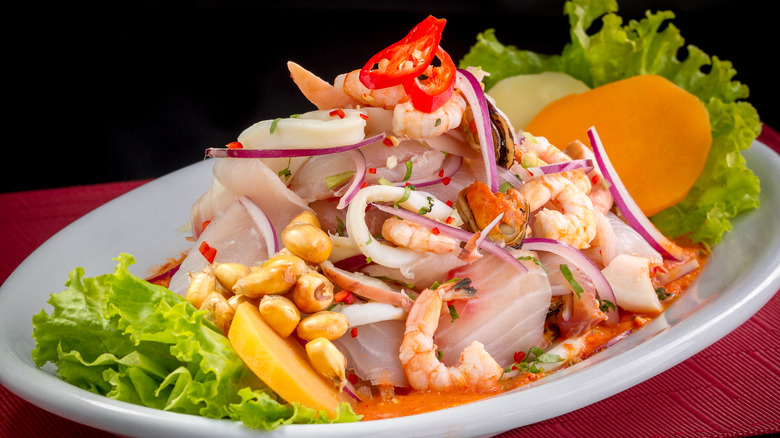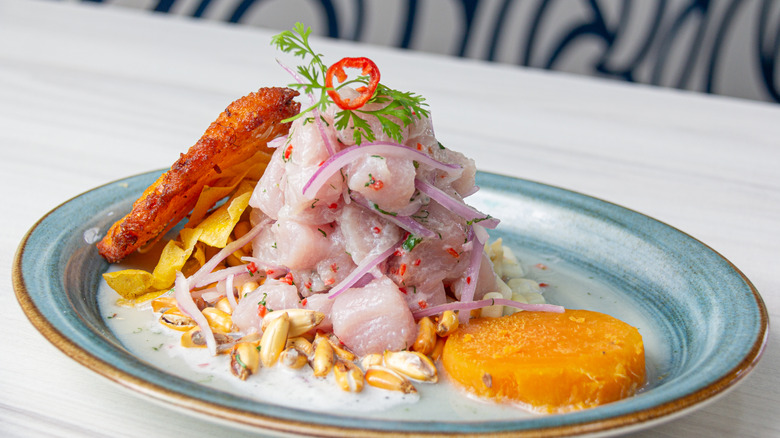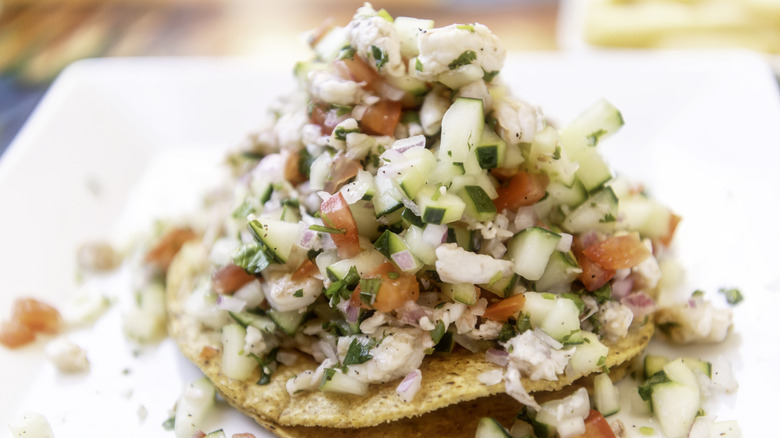How To Choose The Best Fresh Fish For Ceviche
Ceviche is one of global cuisine's most interesting oddities, a "cooked" food that involves no heat at all, but instead uses a strong citrus acid (like lime or lemon juice) to denature the proteins inherent in fish, giving them the qualities of having been cooked. It's a national dish, basically from Mexico all the way down to Chile, and there's no single universally agreed-upon recipe. Pretty much, the only requirement is that it has to involve seafood and citrus juice; past that, there are varieties with onions, peppers (chili or bell), plantains, cilantro, avocado, tomato, soda crackers and so much more, a true kaleidoscope of options.
As it turns out, this "whatever ingredients you feel like" rule applies to the fish as well. If making ceviche, feel free to experiment with the key ingredient. There are very few edible things that can be pulled out of the ocean that wouldn't work in a ceviche, as long as they're not going to disintegrate when exposed to lime juice. If it's firmer than uni, it should do the trick.
Use any fish for ceviche, the best is up for debate
There's a reason why there are so many variations on ceviche, and why every country along the Pacific coast of the Americas has a different take. Basically, anything works.
Some people will tell you shellfish like shrimp is where it's at, while others might insist a flaky white fish like cod is preferable; still more swear by a heartier central ingredient, like swordfish. The truth is any of them work, it's a matter of personal preference. From bonito to halibut to flounder to sea bass, there are recipes online for seemingly everything; Americans, however, are most familiar with white fish ceviche.
Some Peruvian sources believe ceviche originated with the Moche civilization along the coast of Peru over 2000 years ago; this would explain why it holds a special place for Peruvians as a flagship dish of their culture. But most historians believe it originated during South America's colonization, either in Peru or Ecuador, since limes and lemons were unknown in the Americas prior to that. Theoretically, the Moche explanation is still possible, though, as they could have used the acid from chili peppers to a similar effect as citrus—- although the modern version of the dish definitely showed up much more recently.
So much of ceviche's history is mysterious, it shouldn't be surprising it's so variable
In addition to the vagueness surrounding the origins of ceviche, nobody really knows where the name comes from — or even how it's supposed to be spelled. It could have come from the Quechua (a linguistic family that stretches all throughout northern South America) word "siwichi," which means "fresh fish." It could have also come from the Spanish word "escabeche," which means meat, fish, or vegetables marinated and cooked in vinegar. It's entirely possible it was a combination of the two terms, taking on a hybrid life of its own; language can be mysterious like that. As such, multiple spellings — ceviche, sebiche, seviche, cebiche — are all considered acceptable.
Whatever the etymology of ceviche, don't ever believe anyone who says there's only one type of fish to make it with. The only limit on ceviche is your own imagination, so don't worry that your choice of bay scallops isn't "authentic" enough just because they come from the Atlantic rather than the Pacific. Just make sure you don't skip tasting the marinade when you're preparing it.


